NEC Nederland AP400E-001 AP400E: DECT 6.0 Base Station for external antennas and optional G.729 compression module User Manual
NEC Nederland B.V. AP400E: DECT 6.0 Base Station for external antennas and optional G.729 compression module
user manual
AP400 - All Types
Installation Manual
Issue: May 2012
AP400 – All Types Installation Manual Page 1 of 34 © NEC Nederland B.V. 2012
© NEC Nederland B.V. 2012 Page 2 of 34 AP400 – All Types Installation Manual
A publication of
NEC Nederland B.V.
HILVERSUM, THE NETHERLANDS
Date: May 2012
Great care has been taken to ensure that the information contained in this handbook is
accurate and complete. Should any errors or omissions be discovered or should any user
wish to make a suggestion for improving this handbook, he is invited to send the relevant
details to:
NEC Nederland B.V.
P.O. BOX 32
1200 JD HILVERSUM
THE NETHERLANDS
NEC Nederland B.V., 2012
All rights are reserved. Reproduction in whole or in part is prohibited without written
consent of the copyright owner.
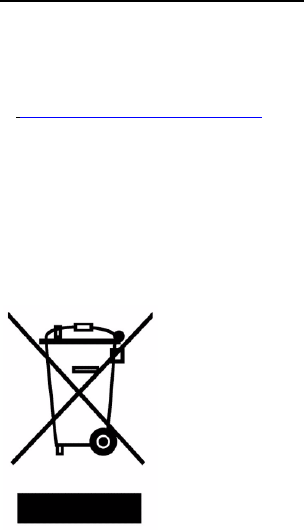
AP400 – All Types Installation Manual Page 3 of 34 © NEC Nederland B.V. 2012
Regulatory information European Union
Declaration of Conformity
Hereby, “NEC Unified Solutions”, declares that this “AP400” is in compliance with
the essential requirements and other relevant provisions of Directive 1999/5/EC.
http://www.nec-unified.com/doc
PRODUCT DISPOSAL INFORMATION (EN)
For countries in the European Union
The symbol depicted here has been affixed to your product
in order to inform you that electrical and electronic
products should not be disposed of as municipal waste.
Electrical and electronic products including the cables, plugs and
accessories should be disposed of separately in order to allow proper
treatment, recovery and recycling. These products should be brought to
a designated facility where the best available treatment, recovery and
recycling techniques is available. Separate disposal has significant
advantages: valuable materials can be re-used and it prevents the
dispersion of unwanted substances into the municipal waste stream.
This contributes to the protection of human health and the environment.
Please be informed that a fine may be imposed for illegal disposal of electrical and
electronic products via the general municipal waste stream.
In order to facilitate separate disposal and environmentally sound recycling arrangements
have been made for local collection and recycling. In case your electrical and electronic
products need to be disposed of please refer to your supplier or the contractual
agreements that your company has made upon acquisition of these products.
At www.nec-unified.com/weee you can find information about separate disposal and
environmentally sound recycling.
For countries outside the European Union
Disposal of electrical and electronic products in countries outside the European Union
should be done in line with the local regulations. If no arrangement has been made with
your supplier, please contact the local authorities for further information.

© NEC Nederland B.V. 2012 Page 4 of 34 AP400 – All Types Installation Manual
Exposure to Radio Frequency (RF) Signals - All Countries:
This device with internal antennas must provide a separation distance of at least 20 cm
from all persons and must not be co-located or operating in conjunction with any other
antenna or transmitter.

AP400 – All Types Installation Manual Page 5 of 34 © NEC Nederland B.V. 2012
Regulatory information United States
This device contains functions which are not operational in US territories
This device complies with part 15 of the FCC rules. Operation is subject to the following
two conditions: (1) This device may not cause harmful interference, and (2) this device
must accept any interference received, including interference that may cause undesired
operation.
Modifications not expressly approved by the manufacturer could void the user’s authority
to operate the equipment.
Note: This equipment has been tested and found to comply with the limits for a Class B
digital device, pursuant to Part 15 of the FCC Rules. These limits are designed to
provide reasonable protection against harmful interference in a residential
installation. This equipment generates uses and can radiate radio frequency
energy and, if not installed and used in accordance with the instructions, may
cause harmful interference to radio communications. However, there is no
guarantee that interference will not occur in a particular installation. If this
equipment does cause harmful interference to radio or television reception, which
can be determined by turning the equipment off and on, the user is encouraged to
try to correct the interference by one or more of the following measures:
Reorient or relocate the equipment.
Increase the separation between the equipment and receiver.
Consult the dealer or an experienced radio/TV technician for help.”
Privacy of communications may not be ensured when using this equipment.

© NEC Nederland B.V. 2012 Page 6 of 34 AP400 – All Types Installation Manual
Exposure to Radio Frequency (RF) Signals:
This base station is a radio transmitter and receiver. It is designed and manufactured not
to exceed the emission limits for exposure to radio frequency (RF) energy set by the OET
Bulletin 65 Supplement C. These limits are part of comprehensive guidelines and
establish permitted levels of RF energy for the general population. The guidelines are
based on the safety standards previously set by international standards bodies. These
standards include a substantial safety margin designed to assure the safety of all
persons, regardless of age and health.
This device with internal antennas must provide a separation distance of at least 20 cm
from all persons and must not be co-located or operating in conjunction with any other
antenna or transmitter.
Regulatory information Canada
This device complies with Industry Canada licence-exempt RSS standard(s). Operation is
subject to the following two conditions: (1) this device may not cause interference, and (2)
this device must accept any interference, including interference that may cause undesired
operation of the device.
Le présent appareil est conforme aux CNR d'Industrie Canada applicables aux appareils
radio exempts de licence. L'exploitation est autorisée aux deux conditions suivantes : (1)
l'appareil ne doit pas produire de brouillage, et (2) l'utilisateur de l'appareil doit accepter
tout brouillage radioélectrique subi, même si le brouillage est susceptible d'en
compromettre le fonctionnement.
Exposure to Radio Frequency (RF) Signals:
This wireless device is a radio transmitter and receiver. It is designed and manufactured
not to exceed the emission limit for exposure to radio frequency (RF) energy set by the
Ministry of Health (Canada), Safety Code 6. These limits are part of comprehensive
guidelines and established permitted levels of RF energy for the general population.
These guidelines are based on the safety standards previously set by international
standards bodies. These standards include a substantial safety margin designed to
assure the safety of all persons, regardless of age and health.
This device with internal antennas must provide a separation distance of at least 20 cm
from all persons.
This device and its antenna must not be co-located or operating in conjunction with any
other antenna or transmitter.
AP400 – All Types Installation Manual Page 7 of 34 © NEC Nederland B.V. 2012
Privacy of communications may not be ensured when using this equipment.
This Class B digital apparatus complies with Canadian ICES-003.
Cet appareil numérique de la classe B est conforme à la norme NMB-003 du Canada.
© NEC Nederland B.V. 2012 Page 8 of 34 AP400 – All Types Installation Manual
AP400 – All Types Installation Manual Page 9 of 34 © NEC Nederland B.V. 2012
Contents:
1 AP400 GENERAL ...................................................................................................... 12
1.1 GENERAL ......................................................................................................... 12
1.2 COUNTRY SELECTION ................................................................................... 12
1.3 SITE REQUIREMENTS ..................................................................................... 13
1.4 TEMPERATURE RANGES ............................................................................... 13
1.5 CABLE SPECIFICATIONS FOR AP400 Types ................................................. 13
1.6 CABLING SAFETY REGULATIONs .................................................................. 14
1.7 INTERNAL ELECTRICAL ISOLATION .............................................................. 14
1.8 G.729 DAUGHTER BOARD .............................................................................. 15
1.9 VISUAL CHECK ................................................................................................ 15
1.10 HORIZONTAL OR VERTICAL MOUNTING....................................................... 15
1.11 INSTALLATION PROCEDURES ....................................................................... 16
1.12 UNPACKING ..................................................................................................... 17
2 ADJUSTING THE ANTENNA POSITION ................................................................... 18
3 MOUNTING THE G.729 DAUGHTERBOARD ............................................................ 23
4 MOUNTING THE AP400 AGAINST A WALL/CEILING .............................................. 26
5 LEDs .......................................................................................................................... 30
5.1 LED Status ........................................................................................................ 30
5.2 LED Colours ...................................................................................................... 31
A SPECIFICATIONS ...................................................................................................... 32
© NEC Nederland B.V. 2012 Page 10 of 34 AP400 – All Types Installation Manual
PREFACE
This manual is applicable for the AP400, DECT Transceiver.
Please note that some product models or features described in this manual may not
be available in all world regions.”
No legal rights can be obtained from information in this manual.
Important:
The equipment described in this manual should be installed and maintained only by
professional and qualified engineers in accordance with the procedures and
instructions described in this manual.
AP400 – All Types Installation Manual Page 11 of 34 © NEC Nederland B.V. 2012
© NEC Nederland B.V. 2012 Page 12 of 34 AP400 – All Types Installation Manual
1 AP400 GENERAL
1.1 GENERAL
This installation Manual is valid for installing a DECT transceiver (AP400) to a wall in
horizontal or vertical position. The AP400 is designed for indoor use. When installing an
AP400 outdoors, please use the dedicated Outdoor Cabinet and appropriate outdoor
cabling
Note that there are two types of DECT Transceivers:
AP400 (with internal antennas).
AP400E with directional antenna.
Note: The AP400E must always be installed/used in the outdoor cabinet! For more
information consult the manual for the Outdoor Cabinet for AP400.
1.2 COUNTRY SELECTION
Country settings are pre-determined by the DAP Controller and this ensures that the
AP400 only operates according to local country regulations. It is not possible for any 3rd
party or end user to alter these settings or download software that controls the RF
parameters.
The variant sold in each country can only operate in the frequency band allowed in that
country. This is ensured by only delivering the correct DAP controller version for each
country.
There are three types of DAP Controllers available for the AP400:
DAP Controller – International.
This version is used in EMEA countries and countries that use the European
frequencies and power levels. In these countries, only the DAP Controller -
International will be delivered, so no other frequencies than the European
frequencies and power levels are possible in this region.
DAP Controller - North America
This version is used in North America and can only use the North American
frequencies and power levels. In these countries, only the DAP Controller – North
America will be delivered, so no other frequencies than the North American
frequencies and power levels are possible in this region..
AP400 – All Types Installation Manual Page 13 of 34 © NEC Nederland B.V. 2012
DAP Controller - Selective Countries.
This version is used in countries with frequency ranges other than EMEA or North
America.
Note: In North America, only the “DAP Controller - North America” will be delivered, so
no other frequencies than the North America frequencies and power levels are
possible in North America.
Note: In Europe, only the “DAP Controller - International” will be delivered, so no other
frequencies than the European frequencies and power levels are possible in
Europe.
1.3 SITE REQUIREMENTS
Usually the Cabinets will be fixed to existing walls in the positions determined by the Site
Survey.
Do not mount the AP400 to a metal wall!
1.4 TEMPERATURE RANGES
The temperature ranges of the AP400:
Temperature range AP400: -5 to 45 C.
The AP400 should not be exposed to sunlight!
The outside temperature range for the AP400 (all types) mounted in the Outdoor Cabinet
is as follows:
Minimum outside temperature: -20 C
Maximum outside temperature: 45 C
The Outdoor Cabinet should not be exposed to sunlight!
1.5 CABLE SPECIFICATIONS FOR AP400 Types
The cabling to the AP400(E) should be “Category 5” or “Category 6” Ethernet cabling. The
interface is defined as an SELV interface according EN60950-1. For this reason the
safety restriction as given in the next chapter should be respected:

© NEC Nederland B.V. 2012 Page 14 of 34 AP400 – All Types Installation Manual
The power for the AP400(E) must be supplied via the Ethernet cable, PoE (IEEE
802.3af). There is no room for a Mains Power adaptor inside the Outdoor Cabinet.
Note: “Category 7” cabling is not supported!
Note: PoE source must comply with clause 2.5 (Limited Power Source) per EN 60950-1
1.6 CABLING SAFETY REGULATIONs
Please read the following notes carefully:
Note: When you are going to install an AP400(E) outdoors, it should always be installed
in an Outdoor Box.
Note: The cabling and/or the AP400(E) may never be exposed to over-voltages (e.g.
lightning) without proper protection.
Therefore mind the following notes:
Note: When the AP400 is installed in the Outdoor Cabinet, and the Outdoor Cabinet is
mounted against a wall, lead the cable directly indoors. This avoids that the cable
becomes sensitive to over-voltage. In that case, no lightning protection is needed.
It is strongly recommended to use shielded Cat 5 cable. Make sure that the shield
of the cable is connected to a proper “ground”.
Note: When the AP400 is installed in the Outdoors and cabling runs outdoors, the
cabling will be exposed to lightning and over-voltage. You must use lightning
arrestors/protectors which comply with the local regulations and legislation.
Furthermore, the cabling outdoors, must be shielded Cat. 5 cabling. Make sure
that the shield of the cable is connected to a proper “ground”.
1.7 INTERNAL ELECTRICAL ISOLATION
The AP400(E) provides internal isolation (1,5 kV) between the Ethernet connection and
the internal electrical components, including the antenna’s and antenna connector in the
AP400E in the AP400.
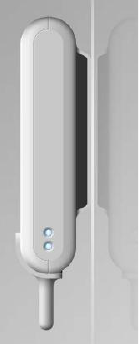
AP400 – All Types Installation Manual Page 15 of 34 © NEC Nederland B.V. 2012
1.8 G.729 DAUGHTER BOARD
The AP400 does support the G.729 codec, but only if the G.729 Daughter Board is
installed.
If the G.729 Daughter Board is not installed, the AP400 supports only G.711u law or
G.711a law.
Installation of the Daughter Board is described in chapter 3. MOUNTING THE G.729
DAUGHTERBOARD.
1.9 VISUAL CHECK
The equipment must be carefully unpacked and examined for any visible sign of damage.
Anything not in order should be reported back to the supplier, as soon as possible, to
avoid delays during installing due to missing equipment.
1.10 HORIZONTAL OR VERTICAL MOUNTING
The AP400 can be mounted horizontally or vertically. When mounting vertically, you don’t
need to change the antenna position.
Figure 1. AP400 in vertical position.
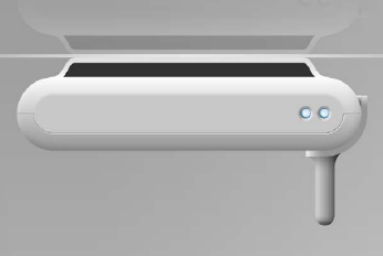
© NEC Nederland B.V. 2012 Page 16 of 34 AP400 – All Types Installation Manual
When the AP400 is mounted horizontally, the antenna position must be changed (see
chapter 2).
Figure 2. AP400 mounted horizontally
1.11 INSTALLATION PROCEDURES
The installation of an Outdoor Cabinet comprises the installation of:
Adjusting the Antenna position (if necessary).
Mounting the G.729 Daughter Board (if applicable)
Mounting the AP400 against the wall.
Connecting directional antennas, if necessary.
Note: The minimum distance between AP400s (DECT Access Points) must be more
than 1 meter. (However, it is strongly recommended to respect a minimum
distance of 5 meters between the AP400s.)
AP400 – All Types Installation Manual Page 17 of 34 © NEC Nederland B.V. 2012
1.12 UNPACKING
PROCEDURE: “Unpacking”.
Actions
1. Open the card board box and take the AP400 out.
2. Check the AP400 for any damage.
3. Continue with one of the following Chapters:
When you mount the AP400 vertically, the antenna position will normally be OK,
and when you do not need to install the G.729 Daughter Board, continue with
Chapter 4 MOUNTING THE AP400 AGAINST A WALL.
When you mount the AP400 horizontally, you must change the antenna position.
Consult Chapter 2. ADJUSTING THE ANTENNA POSITION.
When you require G.729 codec support, you will have to install the G.729
Daughter Board. Consult Chapter 3. MOUNTING THE G.729
DAUGHTERBOARD.
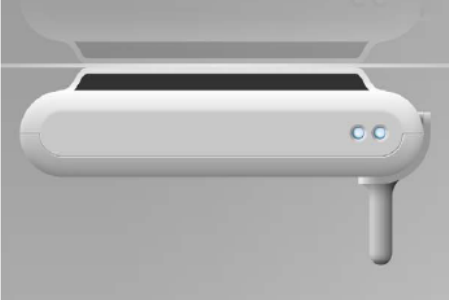
© NEC Nederland B.V. 2012 Page 18 of 34 AP400 – All Types Installation Manual
2 ADJUSTING THE ANTENNA POSITION
This chapter is not applicable for the AP400E.
Note: You only need to change the antenna position when you mount the AP400
horizontally! In all other cases you don’t need to change the antenna position.
Figure 3. AP400 mounted horizontally
PROCEDURE: “Adjusting the Antenna position”.
Note: Antenna position can be changed once. You should not change it back!
Actions
1. Remove the two screws from the rear side of the cabinet.
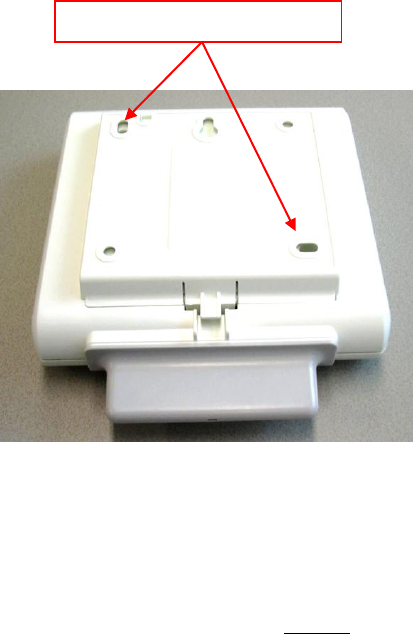
AP400 – All Types Installation Manual Page 19 of 34 © NEC Nederland B.V. 2012
Figure 4. Rear side of Cabinet.
2. Open the cabinet CAREFULLY! Make sure that you shift the cover of the antenna’s
carefully from the antenna’s.
3. Take the antenna cover from the AP400 cover.
4. To put the antennas in vertical position, bend them carefully as shown in Figure 5.
Bend Antennas carefully into vertical position.
Screws are inside these holes
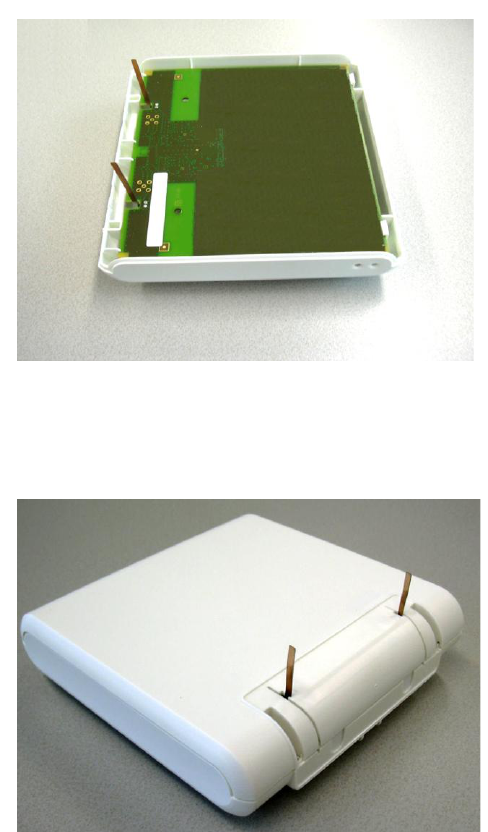
© NEC Nederland B.V. 2012 Page 20 of 34 AP400 – All Types Installation Manual
Figure 5. Bend Antennas carefully into vertical position.
5. After the antennas are put in the vertical position, close the AP400 cabinet again. In
other words, put the AP400 cover back into position and secure the screws at the
rear side of the cabinet. See Figure 6. Antennas locked into Cover.
Figure 6. Antennas locked into Cover.
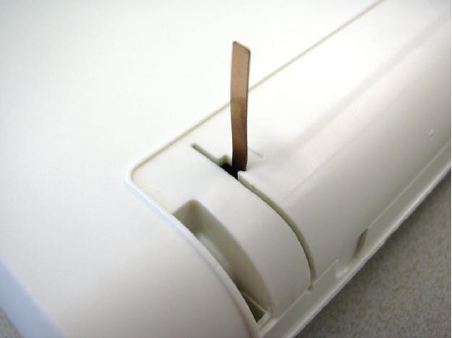
AP400 – All Types Installation Manual Page 21 of 34 © NEC Nederland B.V. 2012
6. Make sure that the antennas are properly locked into the locks in the AP400 cover.
Figure 7. Detail of Antenna in lock.
7. Move the antenna cover carefully over the antennas in the vertical position and make
sure that the antennas do not bend. When the antenna cover is in its position, push it
further into its position in the AP400 cabinet to fix it.
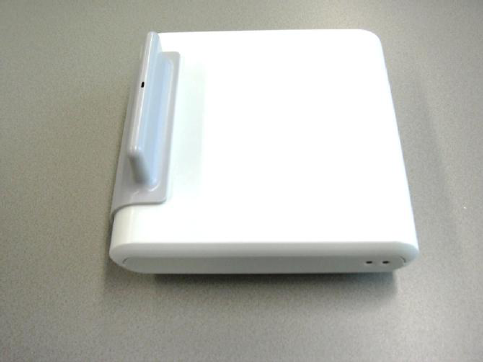
© NEC Nederland B.V. 2012 Page 22 of 34 AP400 – All Types Installation Manual
Figure 8. Cover installed.
8. Now your AP400 is ready to be installed.
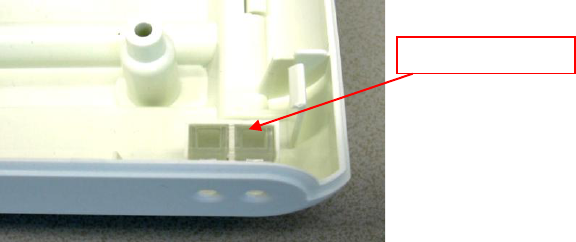
AP400 – All Types Installation Manual Page 23 of 34 © NEC Nederland B.V. 2012
3 MOUNTING THE G.729 DAUGHTERBOARD
Follow the step-by-step procedure below, to install the G.729 daughter board.
PROCEDURE: “Installing the G.729 Daughter Board”.
Actions
1. Make sure that you have the G.729 Daughter board.
2. Open the cabinet. Use steps 1 and 2 in Chapter 2.
3. Take the PCB out of the cabinet.
Note: Mind the light conductor for the LEDs. It can drop off!
Figure 9. Light conductor for LEDs
4. Now you should have the AP400 PWB and the G.729 Daughter Board as separate
items.
5. Remove the protection foil from the sticky part on the G.729 Daughter Board.
LED Light conductor
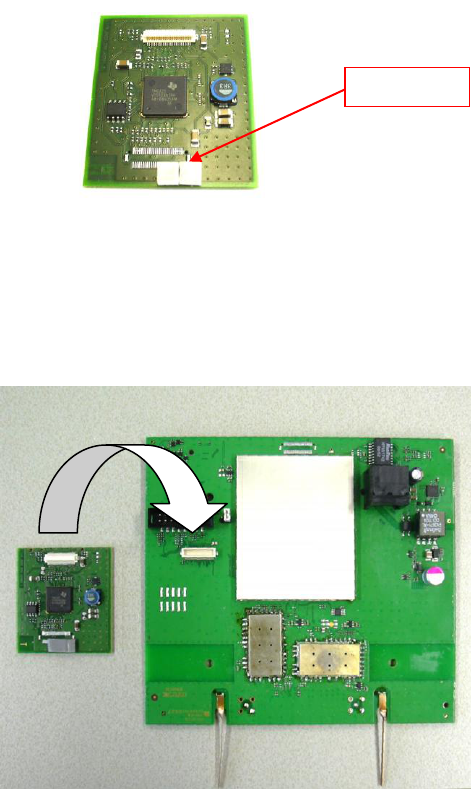
© NEC Nederland B.V. 2012 Page 24 of 34 AP400 – All Types Installation Manual
Figure 10. G.729 Daughter Board with sticky foam
6. Mount the G.729 Daughter Board onto the main PWB. Push the Daughter Board
carefully onto the main board. The white connector should fit well. Make sure that the
sticky part sticks to the Main Board.
Figure 11. Mounting the G.729 Daughter Board onto the Main board.
Sticky foam
AP400 – All Types Installation Manual Page 25 of 34 © NEC Nederland B.V. 2012
7. Put the AP400 together in the reverse order as it was disassembled, mounting the
PCB into the cabinet and assembling the cabinet. Do not forget to mount the two
screws back into the rear side of the cabinet.
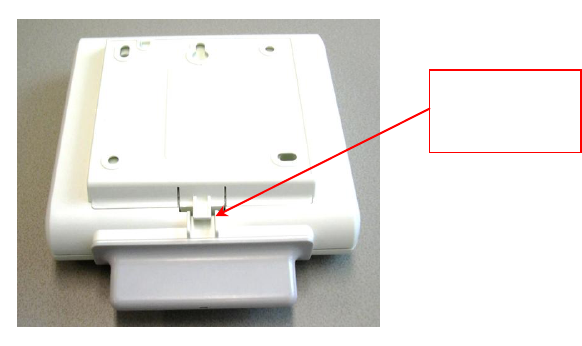
© NEC Nederland B.V. 2012 Page 26 of 34 AP400 – All Types Installation Manual
4 MOUNTING THE AP400 AGAINST A
WALL/CEILING
PROCEDURE: “Procedure for mounting the AP400 to the wall”.
Actions
1. Remove the mounting plate from the AP400 cabinet.
Figure 12. How to take the mounting plate off.
Push clip up, to
take mounting
plate off.
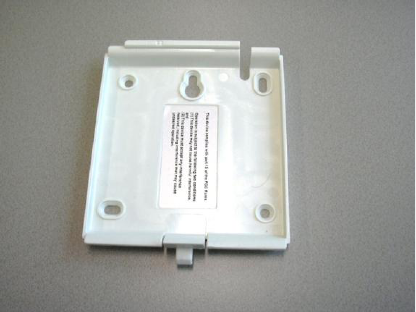
AP400 – All Types Installation Manual Page 27 of 34 © NEC Nederland B.V. 2012
2. Mount the mounting plate to the wall or ceiling, using appropriate fitings.
Figure 13. Mounting plate..
3. Make sure that the Ethernet cable to the cabinet has the correct length.
4. If necessary, mount the RJ45 connector to the cable using the tool for mounting an
RJ45 connector plug to a Category 5 or Category 6 cable.
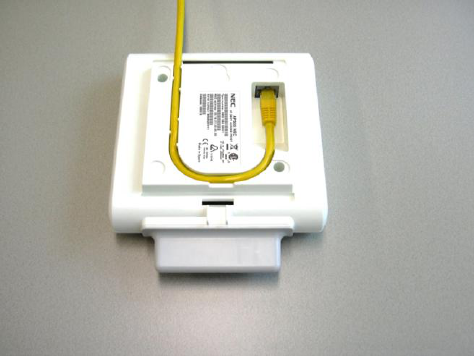
© NEC Nederland B.V. 2012 Page 28 of 34 AP400 – All Types Installation Manual
5. Lead the cable to the AP400 cabinet and connect the RJ45 connector. Push the
cable into the groove.
Figure 14. Cable at rear side of the cabinet.
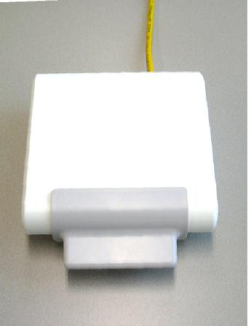
AP400 – All Types Installation Manual Page 29 of 34 © NEC Nederland B.V. 2012
6. Push the cabinet onto the mounting plate.
Note: When pushing the AP400 on to the mounting plate, make sure that you hear/feel
a distinct click. This indicates that the AP400 is firmly mounted to the mounting
plate.
Figure 15. AP400 mounted against the wall.
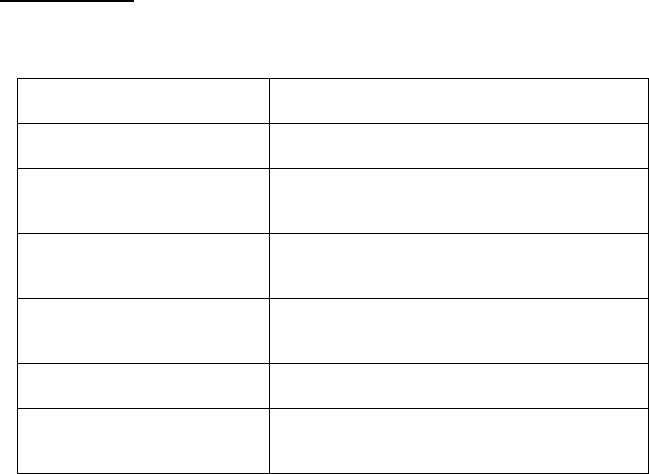
© NEC Nederland B.V. 2012 Page 30 of 34 AP400 – All Types Installation Manual
5 LEDs
5.1 LED Status
The AP400 is equipped with two LEDs.
Top LED – Yellow
This LED represents the status of the AP400.
LED Status (Top LED, Yellow)
Meaning
Off
No power
0,5 seconds On - 0,5 seconds
Off
Loading software/firmware
Short flash every 0,25 seconds
IP Network error (not connected, no DHCP/TFTP
server, no DAP Controller
Fast blink
DAP operational, but trying to synchronize to
another DAP
Continuous fast blink
Hardware error
Steady On
DAP operational (and synchronized to other DAP
or is the synchronization master).
Table 1. AP400 LED Status on top LED
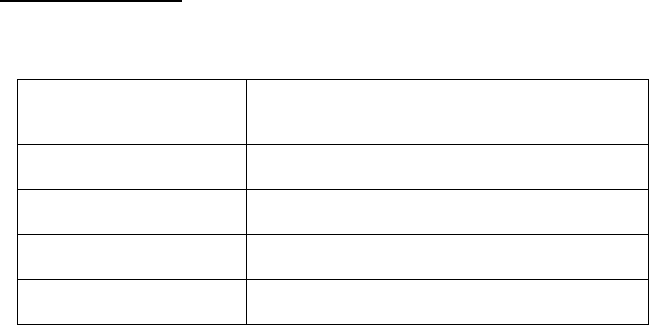
AP400 – All Types Installation Manual Page 31 of 34 © NEC Nederland B.V. 2012
Lower LED – Red/Green
This LED is used to indicate the start-up and network status.
LED Status (lower LED,
Red/Green)
Meaning
RED Steady on
Power but FPGA starting up
RED flashing
Trying to connect to the network
Green flashing
Network status display and showing network activity
Off
AP400 operational
Table 2. Lower LED status on the AP400.
5.2 LED Colours
The colour of the top LED might be different depending on the operational mode. The
following operational modes are distinguished:
Normal (single band) mode
In the normal single band mode, the top LED will be Yellow.
Dual Band Mode
In Dual Band mode, the LED colour shows the operational frequency:
Green : Europe/International
Red : North America / USA

© NEC Nederland B.V. 2012 Page 32 of 34 AP400 – All Types Installation Manual
A SPECIFICATIONS
Dimensions / Environment:
Dimensions (W x D x H) ............................... : 145 x 43 x 174
Outside temperature range ........................... : -5 C . . . 45 C
The AP400 should not be exposed
to sunlight. .
IP Specification ........................................... : When in Outdoor Box = IP66
Relative Humidity ......................................... : 5 . . . 95 %
PoE Specifications:
Voltage at AP400 via PoE ........................... : 36 . . . . 57 V. DC
PoE Class .................................................... : Class 2
Power Consumption ..................................... : 6 Watt maximum
Note: PoE source must comply with clause 2.5 (Limited Power Source) per EN 60950-1
IP Specifications:
IP Network ................................................... : 10/100Base-T IEEE802.3
Connector: ................................................... : RJ45
Cable ........................................................... : Cat 5 / Cat 6 UTP.
Cat 7 is not supported.
IP Version .................................................... : IPv4
DHCP/TFTP support .................................... : Yes
Quality of Service ......................................... : IEEE802.1Q, IEEE802.1P
Audio CODEC:
AP400: ......................................................... : G.711
AP400 with Daughter Board ......................... : G.711 and G.729
Country/Region support:
EMEA ........................................................... : 1880 – 1900 Mhz
Latin America ............................................... : 1910 – 1930 MHz
Brazil ............................................................ : 1910 – 1920 MHz